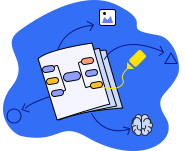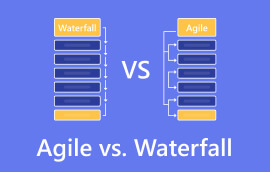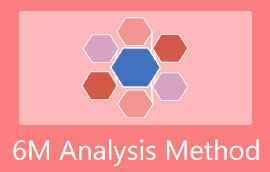What is Waterfall Model: Complete Definition, Pros, and Cons
What is the Waterfall Model? Does it play a big role in the success of a project? If you are curious about this methodology, you must read the whole content from this post. We will give you enough insight about the Waterfall model. It includes its advantages and disadvantages. It includes its advantages and disadvantages. We will also give you a simple tutorial about creating a diagram for your Waterfall method. Proceed to this post and begin getting all the knowledge about the discussion.

- Part 1. What is Waterfall Model
- Part 2. Uses of Waterfall Model
- Part 3. Advantages and Disadvantages of Waterfall Model
- Part 4. How to Use Waterfall Model
- Part 5. FAQs about Waterfall Model
Part 1. What is Waterfall Model
The Waterfall model/method is a sequential approach to the software development lifecycle. It is common in product development and software engineering. The model utilizes a logical progression of SDLC methods for a project. It is like water flowing over the edge of a cliff. The models set objectives or endpoints for each phase of development. Those objectives will be revisited after the completion. In the industrial design application, the waterfall model is still the best method to use. It uses general high-level project management procedures for complex and multifaceted projects. Well, various users use the waterfall model. These are the project managers and project teams. They are using the model to achieve objectives based on their business needs. Also, you can use the waterfall model in various project management contexts. It includes manufacturing, construction, software development, and IT industry. Furthermore, projects based on the model are predictable, well-defined, and have certain documentation. They also have various characteristics. These are fixed requirements, established time, great technology, and ample sources.
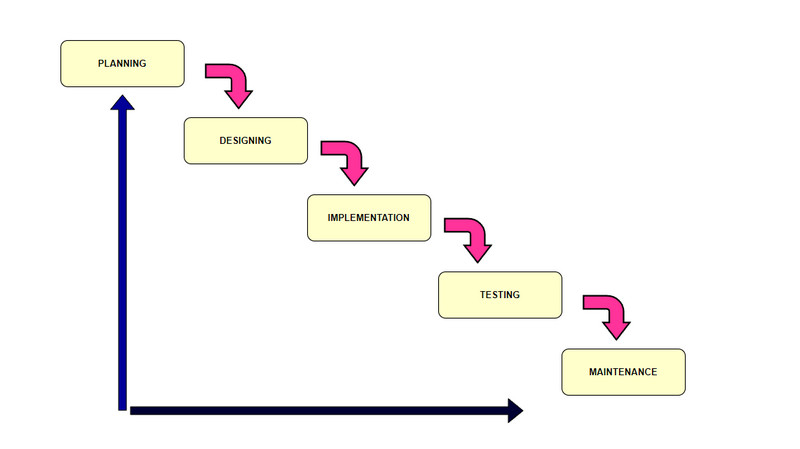
Also, the waterfall method of project management is chronological. It has five phases that can make it more understandable. These phases are requirements, design, implementation, verification, and maintenance. To give you more idea, see the complete description of each phase.
Requirements Phase
In these five phases, requirements are usually inserted into a single document. It is used for the verification of each phase or stage. It is also composed alongside constraints, non-functional, and functional needs of the project.
Design Phase
HLD, or a high-level design, is developed to describe the main purpose and the scope of the project. Design is the general traffic flow of every component. Once the requirement is collected, the design is created. It involves defining the components, modules, architecture, and data for the system. Always remember that the design is documented in detail.
Implementation/Coding Phase
In the implementation phase, the team works on the design. It is to implement, code, create, and test solutions. A single document must be as clear as possible. This phase is also where the design is turned into executable code.
Verification or Testing Phase
In the verification phase, acceptance tests are deployed and executed. It is to assess whether the constructed solution aligns with the specified requirements. It includes confirming whether the project aligns with its initial expectations. Then, it is followed by a review to establish corrective measures.
Maintenance Phase
The last phase is the Maintenance phase. When the software is deployed, it enters the maintenance phase. It involves fixing bugs, making updates, and adapting software to changes. This phase can last for an extended period. It depends on the life cycle of the software.
Part 2. Uses of Waterfall Model
The Waterfall Method has many uses. It helps an organization to finish their projects. To know various use cases of the Waterfall Model, you can see the data below.
Educational Purposes
The Waterfall Model is used in educational settings. It has a big role in teaching basic concepts of software development. Its sequential nature guides learners to understand the logic of the development procedure.
Legacy Systems Maintenance
The Waterfall Model is effective for maintaining and updating stable legacy systems, emphasizing the preservation of existing functionality. Its structured, sequential approach aligns well with the predictable nature of such projects.
Regulatory Industries
The Waterfall method is perfect for industries with strict requirements, like healthcare and finance. The model is perfect to ensure that the five phases are well-documented and meet the regulatory standard.
With these use cases, you will learn that the Waterfall Model plays a vital role in project management or any processes. It helps all users to accomplish their goals with their desired outcomes.
Part 3. Advantages and Disadvantages of Waterfall Model
In this section, you will learn the Waterfall Method's pros and cons. So, to discover all of them, see the method’s good sides and limitations.
Advantages
Comprehensive Documentation
The Waterfall Model can produce detailed documentation. It is helpful to understand the project and future maintenance.
Stability in Project Scope
The model is perfect for projects with well-defined and stable requirements.
Well Defined Phases and Clear Structure
The Waterfall method has a straightforward structure. It has distinct phases that offer a clear roadmap for development.
Disadvantages
Limited Flexibility to Changes
The method has the inflexibility to accommodate changes once the phase is done. When there are changes, it is required to go back to the beginning of the process.
Unsuitable for Evolving Projects
Projects that are evolving may find the Waterfall Model impractical. It can’t adapt well to changes that can’t meet the client’s expectations.
Part 4. How to Use Waterfall Model
If you want to use the Waterfall model in your project, you must know the general procedure. If not yet, we are here to give you a simple guide.
Thorough Planning
It is important to invest time in the planning phase. It is to ensure that requirements are documented. Planning is the best foundation for future success.
Clear Documentation
Documenting each phase is recommended. It includes design specifications, requirements, and testing results. Clear documentation is important for monitoring progress.
Change Control
Implementing a strict change control mechanism is better. Changes to requirements after the progressed project to later stages can be challenging in the Waterfall model.
Thorough Testing
You must place a strong emphasis on testing. It is crucial to analyze and address issues early to prevent major rework in the future.
Consider Project Complexity
You must determine the size and complexity of the project. The Waterfall Model is more suitable for small to medium-sized projects with well-defined requirements.
Well, creating a diagram for your project is better for understanding. But the question is what tool to use for the diagram-creation process? In that case, we want to introduce MindOnMap as your best diagram creator. If you are not yet knowledgeable about the tool, let us give you complete information. MindOnMap is among the best diagram creators to use online and offline. It can offer various functions to use for the diagram creation procedure. The tool can provide advanced shapes, font styles, colors, sizes, and more. With these functions, you can create an understandable and wonderful diagram for your Waterfall Model. Aside from that, the tool has a Theme feature to use. The feature allows you to make a colorful background for the diagram. Plus, the main interface of the tool is intuitive. All users can operate the tool without any skills required. Additionally, you can save your final output on your MindOnMap account for further preservation. You can also download the diagram in various formats. You can save them on JPG, PNG, SVG, DOC, and more. Moreover, you can access MindOnMap on browsers and offline platforms. It is available on Google, Opera, Firefox, Safari, Windows, Mac, and more. Follow the simple way below to learn how to create a diagram for the Waterfall Model.
Go to the website of MindOnMap. Then, create your account or connect your Gmail account. You can also select if you want to download the tool or use the web-based version.
Secure Download
Secure Download
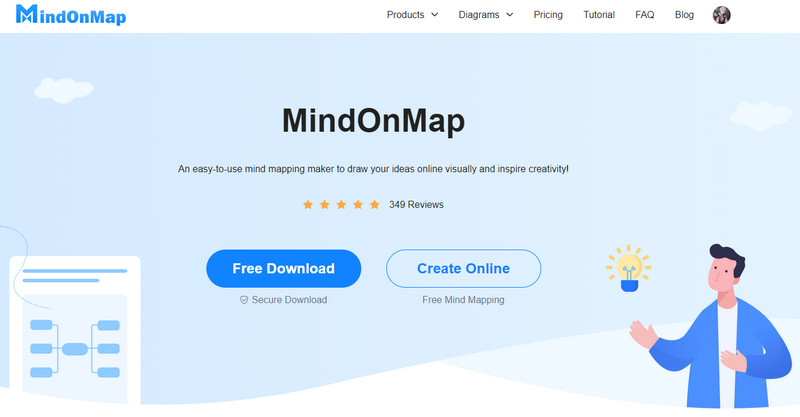
After that, go to the left interface and select the New > Flowchart function. Then, you can begin creating the diagram when the interface shows up.
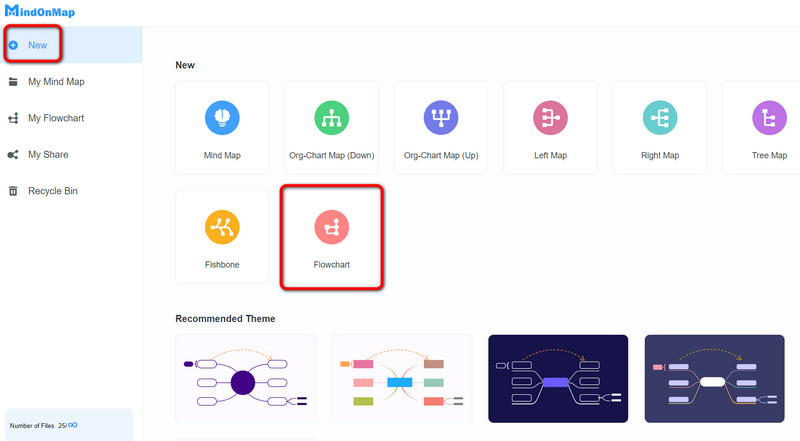
To begin the process, go to the left interface. You can use various shapes for diagrams. You can also utilize the Fill Color option from the top interface to add color to the shapes. To insert text, you need to double-left-click the shape.
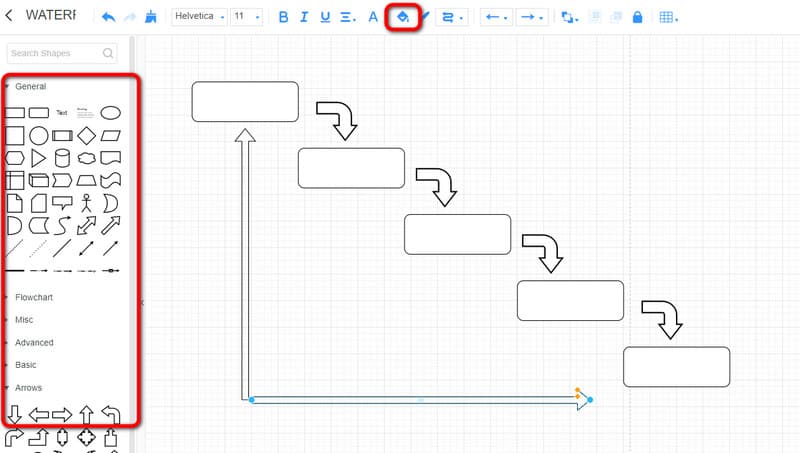
After creating the diagram, you can save it by clicking the Save button from the top right interface. You can also download the diagram from various formats by clicking the Export button.
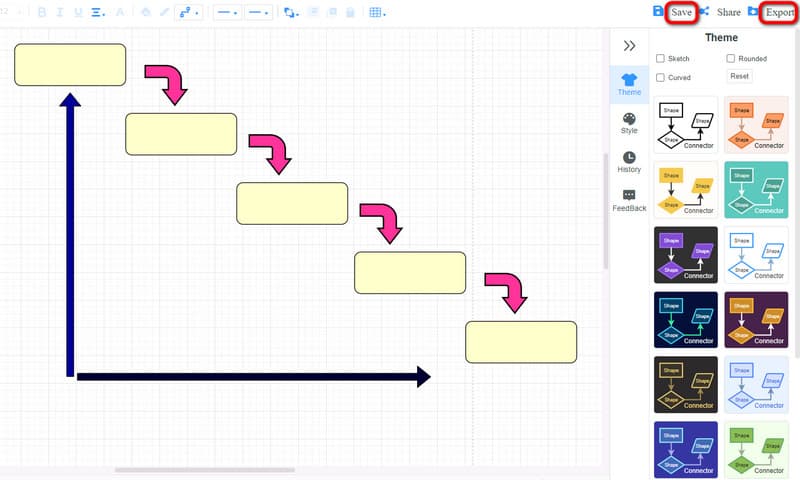
Further Reading
Part 5. FAQs about Waterfall Model
Waterfall model vs Agile, what is the difference?
If you have a small to mid-sized project, it is better to use the Waterfall method. However, if you are dealing with complex projects, it is better to use Agile methodology.
What are the 5 phases of the waterfall model explanation?
The five phases are the requirement, design, implementation, verification, and maintenance phases. These phases are important for the best project management.
What is an example of a waterfall strategy?
The best example of a Waterfall strategy is developing a simple website. With this, you must undergo the five phases. These are requirement, design, implementation, verification, and maintenance phases. The Waterfall is suitable since the project is stable.
Conclusion
In conclusion, the Waterfall Model is a sequential approach to software development, where the phases must be completed before moving on to the next. It is suitable for projects with well-defined and stable requirements. Also, if you are looking for the best tool for creating a diagram for the method, use MindOnMap. This diagram creator can offer every element you need for the diagram creation procedure.








